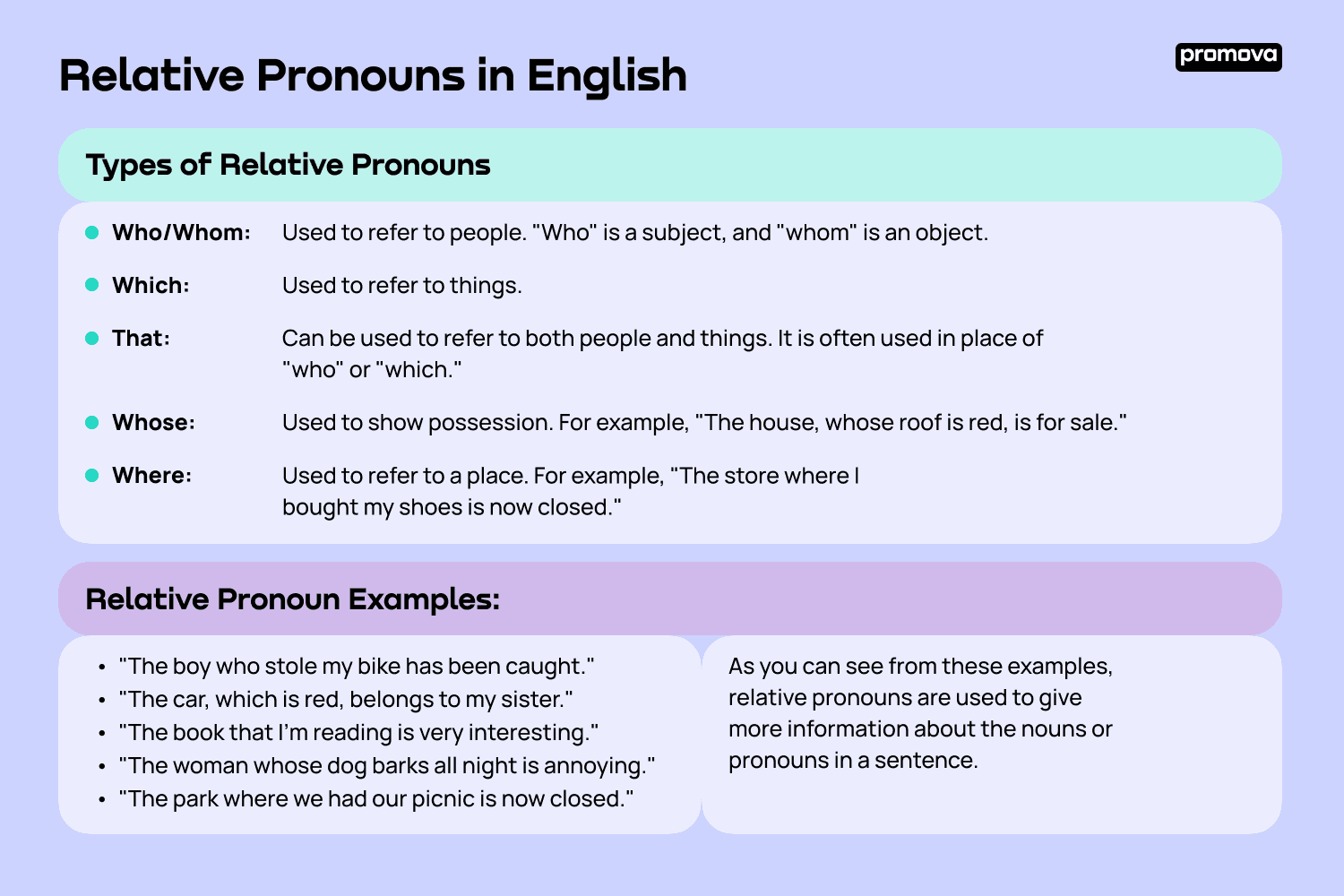Relative Pronouns in English
Contents
As you learn more about the English language, you'll come across a wide variety of grammatical concepts. One of these concepts is the relative pronoun. In this reference, we'll explore what a relative pronoun is, the different types of relative pronouns, and common mistakes to avoid when using them.
What is a Relative Pronoun?
A relative pronoun helps us connect a clause or phrase to a noun or pronoun. It helps to give more information about the noun or pronoun in question, and it is often used to create complex sentences. In other words, a relative pronoun acts as a bridge between two parts of a sentence.
Here's an example of a sentence that uses a relative pronoun:
"The book, which is on the table, is my favorite."
In this example, the relative pronoun "which" connects the clause "is on the shelf" to the noun "book." The relative pronoun "which" also helps to give more information about the book - specifically, where it is located.

Types of Relative Pronouns
There are several types of relative pronouns in the English language. Some of the most common ones:
- Who/Whom: Used to refer to people. "Who" is a subject, and "whom" is an object.
- Which: Used to refer to things.
- That: Can be used to refer to both people and things. It is often used in place of "who" or "which."
- Whose: Used to show possession. For example, "The house, whose roof is red, is for sale."
- Where: Used to refer to a place. For example, "The store where I bought my shoes is now closed."
Relative Pronoun Examples
Here are some more examples of sentences that use relative pronouns:
- "The boy who stole my bike has been caught."
- "The car, which is red, belongs to my sister."
- "The book that I'm reading is very interesting."
- "The woman whose dog barks all night is annoying."
- "The park where we had our picnic is now closed."
As you can see from these examples, relative pronouns are used to give more information about the nouns or pronouns in a sentence.
Relative Pronouns vs. Personal Pronouns
It's important to note that relative pronouns are different from personal pronouns. Personal pronouns (which are "I," "you," "he," "she," "it," "we," and "they") are used to replace nouns in a sentence. Relative pronouns, on the other hand, are used to connect clauses or phrases to a noun or pronoun.
For example, here's a sentence that uses a personal pronoun:
"I saw her at the store yesterday."
In this example, the personal pronoun "her" replaces the noun (presumably a person) that the speaker saw at the store. The sentence doesn't contain a relative pronoun because there is no connection between clauses or phrases.
4
Common Mistakes with Relative Pronouns
One common mistake that learners make when using relative pronouns is using the wrong pronoun for the situation. For example, using "who" instead of "whom" when referring to an object or using "that" instead of "who" when referring to a person.
Another mistake is using too many relative pronouns in one sentence. This can make the sentence confusing and difficult to understand. It's important to use relative pronouns sparingly and only when necessary.
How to Identify Relative Pronouns in a Sentence
Identifying relative pronouns in a sentence is fairly simple. Look for words that connect clauses or phrases to a noun or pronoun. These words are often relative pronouns.
For example, in the sentence "The dog, which is brown, barks all night," the word "which" connects the phrase "is brown" to the noun "dog."
List of Relative Pronouns in English
To help you better understand relative pronouns, here is a full list again for reference:
- Who/Whom
- Which
- That
- Whose
- Where
Summary
Relative pronouns help to create complex sentences and give more information about the nouns and pronouns in a sentence. Understanding the different types of relative pronouns, how to use them correctly, and common mistakes to avoid are all essential for clear and effective communication.
Remember, when using relative pronouns, it's important to be clear and concise. Use them sparingly and only when necessary. With practice, you'll become more comfortable using relative pronouns in your writing and speech!



Comments